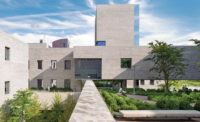Architecture, a slow art that takes time to be realized, is expected to last for years. But surprisingly often, a building is remodeled, expanded, or even torn down, before its once-imagined expiration date. This weekend, the Hood Museum of Art at Dartmouth College in Hanover, New Hampshire, reopens as an intriguing case study of this process.
Originally designed in 1985 by Charles Moore and Chad Floyd of the Connecticut firm Centerbrook Architects and Planners (RECORD, February 1986), the narrow, dark brick building was an energetic example of the postmodern architectural style—replete with a cornucopia of arches, Egyptoid columns, Flemish bond brickwork, bullnose stringcourses, a rotunda, and much more. Today, 34 years later, it looks quite different after an intensive modernist reworking by Tod Williams Billie Tsien Architects (TWBTA) of New York. The need to add more gallery and office space, update mechanical systems, plus attend to wear and tear prompted the undertaking.
The elongated site was hardly promising for expansion. Moore’s art museum, which faces north to the historic Dartmouth Green, was wedged between the Richardsonian Romanesque Wilson Hall of 1884 and the 1962 modernist monumental Hopkins Center by Wallace K. Harrison. Yet TWBTA found a way to expand the original footprint, increasing the size of the museum by 50 percent to 62,400 square feet. That meant, however, partially demolishing the 1985 structure, including Moore’s evocative, arched gateway that led to an open-air entrance courtyard. TWBTA has replaced the original courtyard with a soaring atrium that now functions as a lobby and social space. In addition, the architects fit new galleries into the northern end of the courtyard to accommodate the museum’s prestigious art collection of Old Masters, American, Native American, African, and Indian art. Besides renovating the ten Moore-designed galleries, TWBTA has added six new ones on the ground and second floor levels, which brings the gallery space to 16,350 square feet—a 42 percent increase over the 1985 museum.
One significant part of the brief called for the creation of the Center for Object Study. As the museum’s director John Stomberg points out, Hood’s renown as a teaching museum is based on a program of introducing art to students of various disciplines such as anthropology, biology, and engineering on undergraduate and graduate levels; even possible future clients of architecture, enrolled in Dartmouth’s Tuck Business School, can take advantage of the curriculum. The expansion provides three new classrooms for researching and teaching on the ground floor. (The third floor is turned over to offices, and the lower level provides storage and exhibition preparation space.)
Tod Williams and Billie Tsien’s rectilinear design involved converting Moore’s often unpredictable thread of galleries, niches, and crannies into a more open and clear unfolding of spaces. As Tsien says, “We wanted to simplify and intensify the spaces of the original.” The architects kept Moore’s ceremonial staircase marked by concrete piers, but did add a more minimal stair at the northern end to relieve congestion.
The $50-million expansion has attracted its share of controversy. Critics have pointed out the irony of the firm dealing such a blow to one of Moore’s better known projects when their own Folk Art Museum in New York was razed by the Museum of Modern Art for its own expansion. Tsien replies: “This is not the same thing. We kept much of Moore’s legacy and then added and moved parts around.“ She adds, “We were given a ball of string with a lot of knots it in it.”
Nevertheless, the radical transformation, especially with the erasure of Moore’s facade, is attracting comment, as part of a larger, ongoing discussion about saving postmodernist architecture. (See coverage of the AT&T Building in New York.) TWBTA replaced Moore’s beefy brick gateway with a more abstract, off-white, brick facade in which a large 14-foot-square window juts out from the second floor gallery. (There is no final exterior photography yet as the facade is still undergoing finishing touches.) In the old days, some visitors complained that Moore’s dark entryway was too recessive; now, there may be those who say the new front is overly prominent. While Moore’s design alluded to the Romanesque style of the Wilson next door, TWBTA’s design is, arguably, more in harmony with the light color and horizontality of Harrison’s Hop. And depending on what you think of this—one of Harrison’s more mediocre works—that may not be a good thing. Yet a full evaluation awaits once the facade and landscaping are fully finished, and the galleries have been open to the public. Then, a closer look should be helpful in determining how slow architecture should be when change is around the corner.















Post a comment to this article
Report Abusive Comment